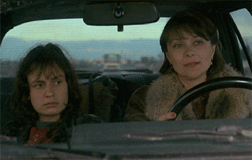Vagabond
(Agnes Varda) 1985
 Sandrine Bonnaire, the lead actress at the center of Agnes Varda’s
mock-documentary Vagabond is one of my favorite French actresses. Her
emotions aren’t always available to us on the surface level, so when they rear
their head the impact is greatly magnified. Her ability to portray both utter
intelligence (as in Rivette’s Secret Defense) and unknowable vacancy,
as she does here, shows an uncommon deal of range. Mona, her character in Vagabond
has dropped out of society for reasons left unstated. Every hint that we get is
greeted with a contradiction. She openly states that she lies to the folks that
she drifts by to entertain herself, and since the film opens by showing us her
death by freezing, and then flashes back attempting to reconstruct a portrait of
her from the accounts of those who barely knew her, many things are left
indefinite. We search Bonnaire’s face for a hint at what lies beneath, but a
misfit like Mona doesn’t exactly comply with our wishes.
Sandrine Bonnaire, the lead actress at the center of Agnes Varda’s
mock-documentary Vagabond is one of my favorite French actresses. Her
emotions aren’t always available to us on the surface level, so when they rear
their head the impact is greatly magnified. Her ability to portray both utter
intelligence (as in Rivette’s Secret Defense) and unknowable vacancy,
as she does here, shows an uncommon deal of range. Mona, her character in Vagabond
has dropped out of society for reasons left unstated. Every hint that we get is
greeted with a contradiction. She openly states that she lies to the folks that
she drifts by to entertain herself, and since the film opens by showing us her
death by freezing, and then flashes back attempting to reconstruct a portrait of
her from the accounts of those who barely knew her, many things are left
indefinite. We search Bonnaire’s face for a hint at what lies beneath, but a
misfit like Mona doesn’t exactly comply with our wishes.
 Over the course of a long winter in rural France, Mona’s nomadic wandering
touches the lives of a surprising number of people. She is offered food and
shelter at many junctures, and is just as often shooed away. Mona usually reacts
to either greeting with the same thankless ambivalence. I personally found her
societal dropout terrifying and her slide toward destruction (chronicled
by the increasing number of broken zippers that dot Mona's outfit) nearly
unbearable, because it reminded me how precarious anyone’s ties to a civilized
life are. Perhaps as a result of my personal horror, Varda surprised me with the
modicum of dourness that she looked at Mona with. Adopting the noncommittal
stance of a documentarian, despite the fact that this particular story is
fictional, the director is as likely to show us the glimpses of joy that are
found in this tale as the moments of misery. Friendship, romance, and a
startling emotional openness all filter their way into this segment of Mona’s
life. When a woman romanticizes her, we are forced to disagree, since we
understand Mona’s eventual fate, but at the same time can understand where
that notion comes from.
Over the course of a long winter in rural France, Mona’s nomadic wandering
touches the lives of a surprising number of people. She is offered food and
shelter at many junctures, and is just as often shooed away. Mona usually reacts
to either greeting with the same thankless ambivalence. I personally found her
societal dropout terrifying and her slide toward destruction (chronicled
by the increasing number of broken zippers that dot Mona's outfit) nearly
unbearable, because it reminded me how precarious anyone’s ties to a civilized
life are. Perhaps as a result of my personal horror, Varda surprised me with the
modicum of dourness that she looked at Mona with. Adopting the noncommittal
stance of a documentarian, despite the fact that this particular story is
fictional, the director is as likely to show us the glimpses of joy that are
found in this tale as the moments of misery. Friendship, romance, and a
startling emotional openness all filter their way into this segment of Mona’s
life. When a woman romanticizes her, we are forced to disagree, since we
understand Mona’s eventual fate, but at the same time can understand where
that notion comes from.
 The dominant emotional response to Varda’s documentary-like
approach is the realization that in recounting their brush with the titular
vagabond, each person interviewed actually reveals more about himself or herself
than about Mona. Both their yearnings for affection and freedom and their
prejudices come out when describing the protagonist. This communal storytelling
device is similar to, but far more emotionally effective than, the one used in Citizen
Kane, in which each interviewee conjectured about the meaning of
“Rosebud”. By listening to how little or how much each person makes about
their encounter with Mona, we seem to understand things that not even the
narrators realize about themselves. Varda has an uncanny ability to turn a few
seconds of dialogue from a non-actor into a moment soul-baring intensity. By
proxy, it becomes clear that our personal response to Varda’s film is as
individualized as each of the characters’ was to Mona. Since there are no
obvious judgments made by the director, our opinion of the protagonist suddenly
matters a great deal, and this allows our response to the film to tell us some
profound things about ourselves. Taken strictly as the narrative of an
unfortunately free young woman, Vagabond is heartbreaking. Taken as an
examination of how we watch and react to the films (and the real people) that we
see, it becomes transcendent.
The dominant emotional response to Varda’s documentary-like
approach is the realization that in recounting their brush with the titular
vagabond, each person interviewed actually reveals more about himself or herself
than about Mona. Both their yearnings for affection and freedom and their
prejudices come out when describing the protagonist. This communal storytelling
device is similar to, but far more emotionally effective than, the one used in Citizen
Kane, in which each interviewee conjectured about the meaning of
“Rosebud”. By listening to how little or how much each person makes about
their encounter with Mona, we seem to understand things that not even the
narrators realize about themselves. Varda has an uncanny ability to turn a few
seconds of dialogue from a non-actor into a moment soul-baring intensity. By
proxy, it becomes clear that our personal response to Varda’s film is as
individualized as each of the characters’ was to Mona. Since there are no
obvious judgments made by the director, our opinion of the protagonist suddenly
matters a great deal, and this allows our response to the film to tell us some
profound things about ourselves. Taken strictly as the narrative of an
unfortunately free young woman, Vagabond is heartbreaking. Taken as an
examination of how we watch and react to the films (and the real people) that we
see, it becomes transcendent.
**** Masterpiece
03-17-02
Jeremy Heilman